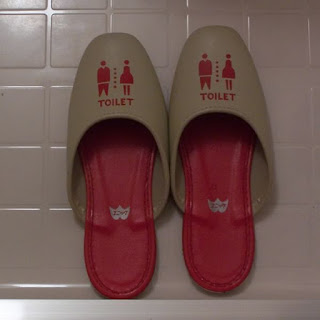My mother is a great
cook – not that I am biased or anything – and she makes a lot of great dishes;
but one of my favorite dishes of hers is her oden.
Oden (おでん) is a Japanese winter dish
consisting of several ingredients such as boiled eggs, daikon radish, konnyaku,
and processed fish cakes stewed in a light, soy-flavoured dashi broth.
Ingredients vary according to region and between each household. Karashi (Japanese mustard) is often used as a
condiment.
Oden was originally what is now commonly called misodengaku
or simply dengaku; konnyaku or tofu was boiled and one ate them with miso.
Later, instead of using miso, ingredients were cooked in dashi and oden became
popular.
Oden is often sold from food carts, and most Japanese
convenience stores like 7-11 or Lawson have simmering oden pots in winter. Many different kinds of
oden are sold, with single-ingredient varieties as cheap as 100 yen.
Oden is a very personal dish and there are many variations
on the ingredients that one puts into their version of oden.
Popular ingredients
Some of the popular ingredients in oden are:
Boiled eggs
Chikuwabu - gluten tubes. Popular in Kantō, virtually unknown elsewhere.
Sliced daikon
Suji - beef tendons
Ito konnyaku
Konnyaku
Konbu
Carrot
Shiitake
Kabocha - Japanese squash
Cabbage roll
Potato
Tsukune - fish or meat balls
Octopus
Tebichi - pig's trotters, only in Okinawa
Tofu products:
Ganmodoki - fried balls of tofu mixed
with grated vegetables
Atsuage - deep fried tofu
Kinchaku (巾着,
literally "pouch") - pouches of thin deep fried tofu (aburaage)
filled with mochi and other ingredients, with the top tied with kanpyō. Also
referred to as fukuro (袋, literally "bag").
Seared Tofu - mainly in Kansai versions
Surimi (fish paste) products: - most of them are already deep fried
before simmering.
Bakudan - boiled egg wrapped in surimi
Chikuwa - thick tubes of surimi
Gobomaki - boiled gobo (burdock root)
wrapped in surimi
Hanpen
Ikamaki - squid wrapped in surimi
wiener-maki, or sausage-maki - wiener
sausage wrapped in surimi
Kamaboko
Shinjoage - fried seafood paste
Regional variations
In Nagoya, it may be called Kantō-ni (関東煮) and
soy sauce is used as a dipping sauce.
Miso oden is simmered in hatcho-miso
broth, which is lightly sweet taste. Konnyaku and tofu are common ingredients.
In Kansai area they are sometimes called Kantō-daki (関東煮
or 関東炊き) and tend to be stronger flavoured than the lighter
Kantō version.
Oden in Shizuoka use a dark colored broth flavoured with
beef stock and dark soy sauce, and all ingredients are skewered. Dried and
ground fish (sardine, mackerel, or katsuobushi) and aonori powder (edible
seaweed) are sprinkled on top before eating.
Udon restaurants in Kagawa Prefecture in Shikoku almost
always offer oden as a side dish, to be eaten with sweet miso while waiting for
the udon.
In Taiwan, the dish is called Heilun/Olun (黑輪) in
the Taiwanese language. Besides the more traditional ingredients, olen also
uses many local ingredients, such as pork meatballs and blood puddings.
More
recently, oden is offered in convenience stores and is known as guandongzhu
(Kuantung-chu; 關東煮) in Mandarin.
In Korea, Odaeng (오댕) is a street food that's sold from small
carts and is served with a spicy soup. It's very common on the streets of Korea
and there are many restaurants that have it on their menu or specialize in it.
Of course, my favorite is my mother's and here is my first bowl from last night - my first of many...oden is something I can just eat and eat!!
As we say in Japan - Oishii!! おいしい!!
Of course, my favorite is my mother's and here is my first bowl from last night - my first of many...oden is something I can just eat and eat!!
As we say in Japan - Oishii!! おいしい!!




































